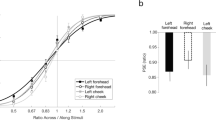Summary
A forced choice paradigm was used to measure the capacity of human subjects to discriminate the curvature of stimuli applied passively to the skin of an immobilized finger. The stimuli consisted of spherically curved segments with a base radius of 2.5 mm; thus the area of contact with the fingerpad skin was approximately 19.6 mm2 for all stimuli. There were 2 series of experiments. In series 1, the standard surface had a curvature of 286 m−1 (radius of curvature 3.5 mm); subjects were able to discriminate an increase in curvature of about 13%. In series 2, the standard had a curvature of 154 m−1 (radius 6.5 mm); subjects were able to discriminate an increase in curvature of about 18%. Thus, even when the contact area between the surface and the skin was invariant, humans were able to discriminate small changes in curvature using only information from the cutaneous receptors.
Similar content being viewed by others
References
Burgess PR, Wei JY, Clark FJ, Simon J (1982) Signaling of kinesthetic information by peripheral sensory receptors. Ann Rev Neurosci 5:171–187
Davidson PW (1972) Haptic judgments of curvature by blind and sighted humans. J Exp Psychol 93:43–55
Fearing RS, Binford TO (1988) Using a cylindrical tactile sensor for determining curvature. Proc IEEE International Conference on Robotics and Automation 765–771
Goodwin AW, John KT, Marceglia AH (1991) Tactile discrimination of curvature by humans using only cutaneous information from the fingerpads. Exp Brain Res 86:663–672
Gordon IE, Morison V (1982) The haptic perception of curvature. Percept Psychophys 31:446–450
Gurfinkel VS, Shneyder AYu, Kanayev YeM, Gurfinkel YeV (1974) Tactile sensitizing of manipulators. Eng Cybern 12:47–56
Johnson KO (1980) Sensory discrimination: decision process. J Neurophysiol 43:1771–1792
LaMotte RH, Srinivasan MA (1987a) Tactile discrimination of shape: responses of slowly adapting mechanoreceptive afferents to a step stroked across the monkey fingerpad. J Neurosci 7:1655–1671
LaMotte RH, Srinivasan MA (1987b) Tactile discrimination of shape: responses of rapidly adapting mechanoreceptive afferents to a step stroked across the monkey fingerpad. J Neurosci 7:1672–1681
Phillips CG (1986) Movements of the hand. Liverpool University Press, Liverpool
Richards W, Dawson B, Whittington D (1986) Encoding contour shape by curvature extrema. J Opt Soc Am 3:1483–1491
Roland PE, Mortensen E (1987) Somatosensory detection of microgeometry, macrogeometry and kinesthesia in man. Brain Res Rev 12:1–42
Srinivasan MA, LaMotte RH (1987) Tactile discrimination of shape: responses of slowly and rapidly adapting mechanoreceptive afferents to a step indented into the monkey fingerpad. J Neurosci 7:1682–1697
Srinivasan MA, LaMotte RH (1990) Encoding of shape in the responses of cutaneous mechanoreceptors. In: Franzen O, Westman J (eds) Information processing in the somatosensory system. MacMillan, London
Author information
Authors and Affiliations
Rights and permissions
About this article
Cite this article
Goodwin, A.W., Wheat, H.E. Human tactile discrimination of curvature when contact area with the skin remains constant. Exp Brain Res 88, 447–450 (1992). https://doi.org/10.1007/BF02259120
Received:
Accepted:
Issue Date:
DOI: https://doi.org/10.1007/BF02259120




